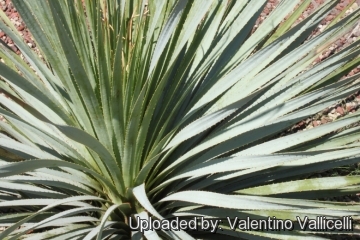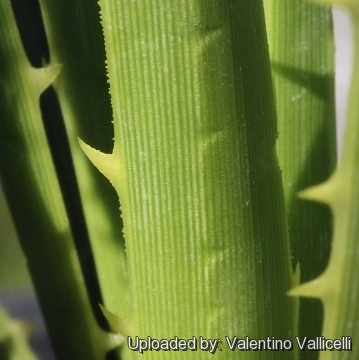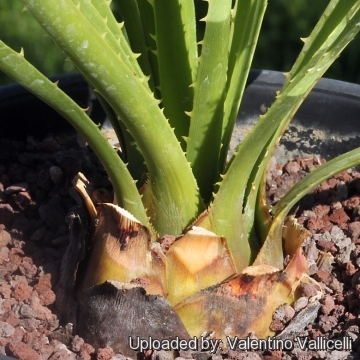




Your support is critical to our success.

Origin and Habitat: Mexico (Chihuahua and Sonora). Southwestern United States (Texas to Arizona)
Altitude: Generally grows at elevations from 500 m to above 1000 meters.
Habitat: Common on slopes, edge of canyons and hills of limestone or granite. It grows in association with mixed desert shrub vegetation such as mariola (Parthenium incanum), feathered dalea (Dalea formosa), prickly pear (Opuntia ssp.), Yucca (Yucca baccata), Agave (Agave parryi), Fendler's ceanothus (Ceanothus fendleri), Cliffrose (Purshia mexicana), pointedleaf manzanita (Arctostaphylos pungens) and ocotillo (Fouqueria splendens).
Synonyms:
- Dasylirion wheeleri S.Watson ex Rothr.
Dasylirion wheeleri S.Watson ex Rothr.
Rep. U.S. Geogr. Surv., Wheeler 272 1878
Synonymy: 2
- Dasylirion wheeleri S.Watson ex Rothr.
- Dasylirion wheeleri var. wislizeni Trel.
ENGLISH: Blue Sotol, Sotol Wheeler, Common Desert Spoon, Saw Yucca, Desert Spoon, Spoon Flower, Common Sotol
SPANISH (Español): Sotol
Description: The desert spoon (Dasylirion wheeleri) is a moderate to slow-growing mounding evergreen shrub. The grass-like succulent leaves radiate from the centre of the plant's apex in all directions.
Stems/Trunks/Caudex: Single, succulents, short-caulescens, unbranched up to 40 cm thick growing to 1,5 m tall (but usually so short it hardly exists ), though often recumbent on the ground. It is usually mounded only; can be pruned to a trunk-like look.
Roots:Thick and fusiform, or spindle shaped (Bogler in press). Young plants usually have two to three large fusiform roots the size and shape of carrots.
Rosette: Large, ball-shaped , with hundreds of long leaves, 120-150 cm in diameter.
Leaves: leaf blade thin, flat, pliable, elongated, 35-100 cm long, 15-20 mm wide, silver-green, bluish green or occasionally green, with a toothed, saw-like margin and split at the tips with frilly fibrelike appendages, teeth yellowish, sharp; petiole base shaped like spoon, hence the common name “Desert Spoon”. Older leaves droop around the base, forming a shaggy mantle that collects water and provides support.
Inflorescence: The flowering stem grows above the foliage, to a height of 5 m tall, and 3-6 cm diameter. The stem is topped by a long plume with thousands of tiny flowers. Female plant inflorescence structure is more rounded, on male plant it is more narrow; the stalk is persistent if not removed.
Flowers: Plants are dioecious, the flowers are insignificant, whitish green to straw-coloured small about 2,5 cm long with six tepals. The colour of the flower determinate the gender of the plant, being more white colored for males and tinged purple-pink for females plants.
Blooming season: may to August.
Fruit: Small brownish, oval, dry-capsule, 5-8 mm long, containing a single seed.
Remark: The similar, but smaller, Dasylirion leiophyllum has teeth that curve toward the leaf base.
Bibliography: Major references and further lectures
1) Matt Warnock Turner “Remarkable Plants of Texas: Uncommon Accounts of Our Common Natives” University of Texas Press, 01/Jan/2010
2) Judy Mielke “Native Plants for Southwestern Landscapes” University of Texas Press, 05/Jul/2010
3) Mary Irish “Texas Getting Started Garden Guide: Grow the Best Flowers, Shrubs, Trees, Vines & Groundcovers” Cool Springs Press, 11/Aug/2013
4) CONABIO. “Catálogo taxonómico de especies de México.” 1. In Ca. nat. México. CONABIO, Mexico City. 2009.
5) Fritz Hochstätter “The Genus Dasylirion. (Nolinaceae) part 2.” In: Piante Grasse. 31:3, 119–120. 2011
6) Fritz Hochstätter “The Genus Dasylirion. (Nolinaceae) part 3.” In: Piante Grasse. 31:4 164–166. 2011
7) Bogler, D. J. “Systematics of Dasylirion: taxonomy and molecular phylogeny.” Bol. Soc. Bot. México 56: 69–76 1995
8) Delena Tull “Edible and Useful Plants of the Southwest: Texas, New Mexico, and Arizona” University of Texas Press, 15/Sep/2013.
9) Smith Prof. Gideon, Gideon Smith “Gardening with Succulents” Struik, 2005
10) Wendy C. Hodgson “Food Plants of the Sonoran Desert” University of Arizona Press, 2001
11) A. Michael Powell “Trees & Shrubs of the Trans-Pecos and Adjacent Areas” University of Texas Press, 05/Jul/2010
12) Leo J. Chance “Cacti and Succulents for Cold Climates: 274 Outstanding Species for Challenging Conditions” Timber Press, 19/Jun/2012
13) Laferrière, Joseph E., & Willard Van Asdall. “Plant use in Mountain Pima holiday decorations.” Kiva 57:27-38.1991
14) Pennington, CW. “The Tarahumar of Mexico, their material culture.” University of Utah Press, Salt Lake City 1963
15) William Trelease “The desert group Nolineae. Dasylirion.” In: Proceedings, American Philosophical Society. 50: 439–440 1911
16) Shreve, F. & I. L. Wiggins. “Veg. Fl. Sonoran Des.” 2 vols. Stanford University Press, Stanford.1964
17) Forest & Kim Starr “Dasylirion wheeleri (Desert spoon)”. Plants of Hawaii. <http://www.starrenvironmental.com>. Web. 27 December 2014

Habit at Enchanting Floral Gardens of Kula, Maui, Hawaii, USA. October 24, 2007. Photo by: Forest Starr & Kim Starr

Dasylirion wheeleri Photo by: Valentino Vallicelli

Dasylirion wheeleri Photo by: Valentino Vallicelli

Dasylirion wheeleri Photo by: Valentino Vallicelli

Dasylirion wheeleri Photo by: Valentino Vallicelli

Dasylirion wheeleri Photo by: Valentino Vallicelli
Cultivation and Propagation: They are slow growing, not widely grown, carefree and durable drought tolerant plant. They are said to be quite hardy to both drought and severe freezes down to – 12° C and although they prefer hot, dry climates, with excellent drainage and a place in full sun they do admirably well even in cool, rainy conditions, so worth trying if you have a sunny sheltered corner. As soon as the soil drains well, they should be OK. Once planted in the ground they never need additional water, though the odd deep watering during summer would encourage more rapid growth (don't water the crown, though they rot easily). These make great specimen plants for xeriscape gardens and blend well in either tropical or arid gardens. Small plants are relatively inexpensive, but larger ones are a fortune. These make excellent potted specimens, and their symmetrical form provides a striking focal point. They thrive best in full sun, but can be grown with some shade and humidity. Plant in very fast draining soil and provide little or no water in winter. Treat like a succulent. Plants in containers can be moved inside during longer cold spells.
Cultural practises: Remove old boom stalk. No need other maintenance.
Propagation: Easy to propagate from seeds.
Uses:
Gardening: Accent plant.
Traditional uses: The tough leaves are woven into mats and baskets and used for thatching and also in making bed matting, cradle mats, back mats (for the carrying frame), headbands and paper. The broad, spoon-like base is often used in dried floral arrangements.
Drink: It may be treated in the same manner as Agaves to produce food and liquor (sotol): pit baked, removed, peeled, crushed, mixed with water, fermented, and used as a beverage
Food: It was used by the Indians for food, the Tohono O'odharn, Apache and Tarahumara sometimes used it for food, primarily by baking the emerging flowering stalls in a manner similar to that of baking agave heads. The San Carlos Apaches ate the flowers. whereas Northern and Southern Tontos ate the seeds. The Tepehuans used the roots in times of food shortage. They pit-baked the roots for several days, then ate the non fibrous portion of the roots.
| Your Actions | |
|---|---|
| Back to Dasylirion index | |
| Back to Agavaceae index | |
 |
Back to Succulents Encyclopedia index |
Privacy stantement - Terms and conditions - How to cite - About us - Feedback - Donate




